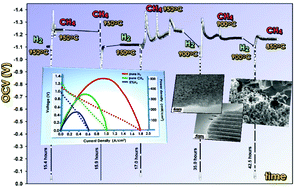A new anode for solid oxidefuel cells with enhanced OCV under methane operation
Abstract
A new SOFC anode material based upon oxygen excess perovskite related phases has been synthesised. The material shows better electrochemical performance than other alternative new anodes and comparable performance to the state-of-art of the electrodes, Ni–YSZ cermets, under pure hydrogen. Furthermore, this material shows an enhanced performance under methane operation with high open circuit voltages, i.e. 1.2–1.4 V at 950 °C, without using steam excess. The effect of the anode configuration was tested in one and four layer configurations. The optimised electrode polarisation resistances were just 0.12 Ω cm2 and 0.36 Ω cm2, at 950 °C, in humidified H2 and humidified CH4, respectively. Power densities of 0.5 W cm−2 and 0.35 W cm−2 were obtained in the same conditions. A very low anodic overpotential of 100 mV at 1 A cm−2 was obtained under humidified H2 at 950 °C. Samples were tested for two days in reducing and oxidising conditions, alternating heating and cooling processes from 850 °C to 950 °C, showing stable


 Please wait while we load your content...
Please wait while we load your content...